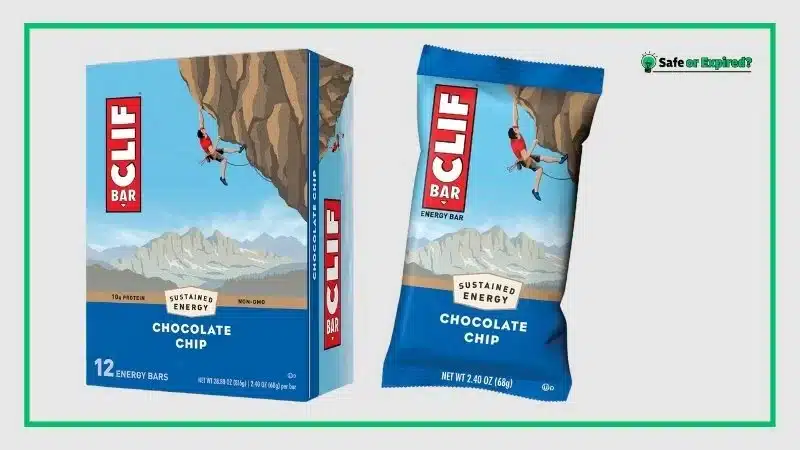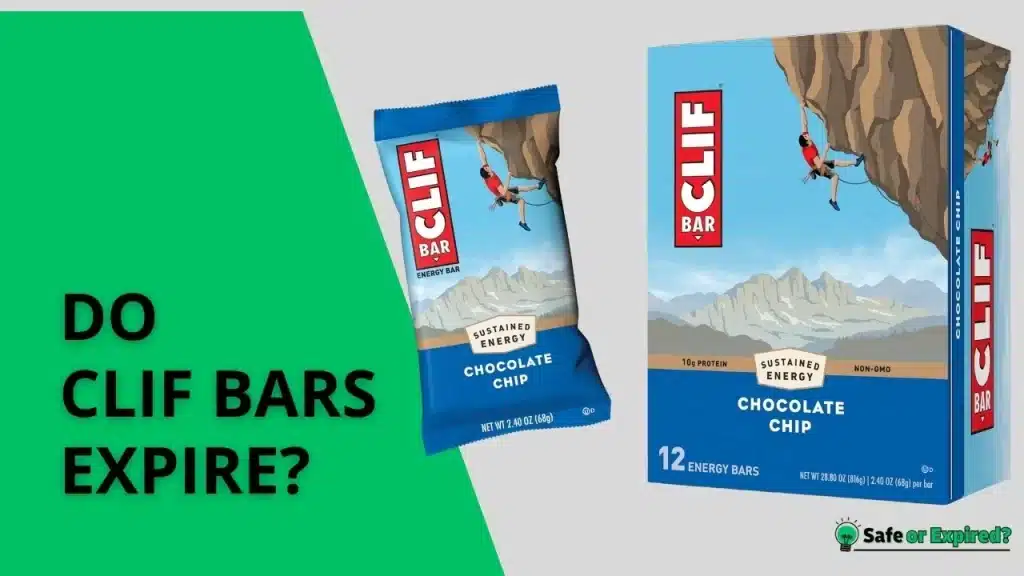“Do Clif Bars expire?” is important to consider, especially if you find an old one in the back of your cupboard. Absolutely, it does expire, but it’s not just about the date on the wrapper. From decoding their expiration format to understanding their storage tips, this guide helps you keep your snacks in peak condition.
So, stick to the end.
Do Clif Bars Expire?
Yes, Clif Bars do expire. The expiration date is indicated on the bar’s packaging. While they may not become harmful after this date, the nutritional value may decrease, and the texture and taste might change. Proper storage practices are vital to maintain their quality.
So, how long do clif bars expire? Typically, Clif Bars have a shelf life of about 6 to 12 months when stored properly. They remain safe to eat beyond this period, but their optimal taste and texture quality will start to decline.
People also ask, “Do clif bars go bad in heat?” Yes. Exposure to high temperatures can cause Clif Bars to spoil prematurely. Heat may lead to the melting of ingredients like chocolate and can alter the bars’ texture and flavor.
You may now be wondering, “Can clif bars be frozen?” Freezing Clif Bars is an effective way to extend their shelf life beyond the printed expiration date. While freezing does not compromise their safety or nutritional content, it may affect their texture. Thawing the bars properly ensures they remain enjoyable to eat.
Here’s a completed shelf life table for Clif Bars, detailing how long they typically last under different storage conditions:
| Storage Location | Opened | Unopened |
| Counter | 1 week | 6-12 months |
| Fridge | 2-3 weeks | 1-1.5 years |
Why Do Clif Bars Have Longer Shelf Life? the Reasons
Clif Bars have a longer shelf life because of their low moisture content and use of preservatives that inhibit microbial growth. These factors help maintain their quality and edibility for extended periods, making them a durable choice for outdoor activities and emergency food supplies.
Preservation Through Ingredients
The formulation of Clif Bars includes natural preservatives such as tocopherols, which are compounds of vitamin E. These serve as antioxidants to prevent the oxidation of the fats within the bars, a process that can lead to rancidity and spoilage.
Additionally, sorbate compounds might be used to inhibit the growth of molds and yeasts. Many also wonder, “Do clif bars have caffeine?” Yes, they do. Caffeine is another reason why Clif bars have a longer shelf life.
Strategic Moisture Control
Clif Bars are designed with a specific moisture content that is low enough to discourage microbial growth but high enough to keep the bars chewable. This balance is crucial in preventing the growth of mold and bacteria without compromising the texture and taste of the bars.
Airtight and Light-Resistant Packaging
The packaging of Clif Bars is not only airtight but also designed to resist light penetration. Exposure to light can degrade certain nutrients and affect the flavor profile of food products. By using materials that block out light and seal tightly against air, the integrity of the bars is maintained over time.
It’s also recommended to keep the clif bars in their original packaging, too.

Ingredient Stability
The choice of stable ingredients, such as oats, nuts, and dried fruits, which are less prone to degradation. These components are less likely to break down over time. This ensures that the bars remain nutritious and satisfying even after extended storage periods.
Together, these factors enable Clif Bars to withstand the test of time, maintaining both their safety and palatability well beyond the production date.
Decoding Clif Bar Expiration Date Format
Clif Bars use a specific format for their expiration dates to inform consumers about the product’s shelf life and peak quality. Understanding this format helps ensure you consume the product while it’s at its best.
Location of the Date
The expiration date on a Clif Bar is typically printed on the back or bottom of the package. It’s often found near the nutritional information or barcode, easily visible once you know where to look.
Date Format Explained
Clif Bars generally use a standard ‘MMDDYY’ or ‘MMYYYY’ format, showing the month and year by which the bar should be consumed. This format indicates the end of the optimal consumption period rather than an exact spoilage date.
Interpretation of the Date
The printed date is a guideline for consuming the bar while it still retains maximum flavor and nutritional benefits. Although the bar might still be safe to eat after this date, its quality in terms of taste and texture may begin to decline.
For example, a “Best By” date might be formatted as “19DEC20,” which means the bar is best consumed by December 19, 2020. This format helps consumers quickly see the optimal consumption period.
How Long Do Clif Bars Last After Expiration Date?
Clif Bars can often remain safe to consume well past their “Best By” date, provided they have been stored correctly. While the bars are unlikely to become hazardous, their optimal taste, texture, and nutritional benefits may degrade over time.
Durability Beyond the “Best By” Date
The “Best By” date on Clif Bars suggests when they are expected to be at their best quality. However, these bars are formulated with ingredients that can withstand degradation longer than many other snack items. Typically, Clif Bars can retain most of their edibility for several months beyond this date.
Impact of Storage Conditions
How you store Clif Bars impacts how long they’ll stay good past their best-by date. To keep them fresh, store them in a cool spot away from heat and sunlight. Avoid extreme temperatures, as both high heat and freezing cold can ruin the texture and taste, especially with ingredients like nuts and chocolate.
Also, note that misinformation can lead to poor food handling. Sort fact from fiction with “Debunking Food Preservation Myths: What You Need to Know.”
Quality Changes Over Time
As time progresses past the “Best By” date, you may notice changes in the texture and flavor of Clif Bars. For instance, bars may become harder or dryer, and flavors may not be as pronounced. While these changes do not necessarily indicate spoilage, they do affect the overall eating experience.
What Are the Signs Clif Bars Have Gone Bad?
When Clif Bars goes bad, several signs are evident. A noticeable off-odor indicates spoilage, possibly from bacterial growth or ingredient oxidation. Visible mold on the bar, in any color, confirms it is no longer safe to eat. Significant changes in texture, such as hardening, excessive dryness, or a slimy feel, also suggest degradation.
Unusual Odor
If a Clif Bar emits an off-putting or sour smell, it’s a strong indicator of spoilage. This change in odor can result from bacterial growth or the oxidation of fats and oils within the bar, which produce rancid smells.
Mold Presence
If you see mold on a Clif Bar, which can look like fuzzy white, green, or black spots, it means the bar has spoiled. Mold is usually caused by moisture, and if you spot it, you should throw the bar away. Moldy bars are unsafe to eat.
Altered Texture
Changes in texture are common in expired Clif Bars. They may become unusually hard, excessively chewy, or even slimy. So, if you’re wondering. “why does my clif bar taste sour,” it means it has gone spoiled.
Discoloration
Any discoloration or uneven color spots on the bar, particularly around natural ingredients like nuts and fruits, can indicate spoilage. These changes can happen due to ingredient degradation or contamination.
Observing these signs can help you determine whether a Clif Bar is still good to eat or if it has gone bad, thereby avoiding potential health risks.
Moreover, knowing why food spoils is also crucial for preventing it. Explore the common reasons in “Factors Leading to Food Spoilage: Know Them.”
Can You Eat Expired Clif Bars?
Expired Clif Bars, while past their “Best By” date, are often still safe to eat if they show no signs of spoilage such as mold, unusual odors, or an off texture. The “Best By” date primarily indicates when a Clif Bar might begin to lose optimal taste and nutritional value. It’s not a strict safety expiration.
However, assessing each bar for spoilage signs before consumption is crucial to ensure it remains safe to eat. Furthermore, following food safety guidelines is essential for health. Review the key recommendations in “Comprehensive Food Safety Guidelines from Top Institutions.”
FAQs
How Long Do Clif Bars Give You Energy?
Clif Bars do provide sustained energy due to their composition of carbohydrates, protein, and fats. Typically, the energy from a Clif Bar can last for several hours.
How Long Does Clif Bar Energy Last?
The energy provided by Clif Bars generally lasts about 2 to 3 hours. This duration is ideal for mid to long-term activities, as the mix of ingredients ensures a gradual release of energy. This is important as it prevents spikes in blood sugar levels.
What Happens If You Eat an Expired Protein Bar? (Find Out)
Eating an expired protein bar, like a Clif Bar, is not usually harmful if it has been stored properly. However, the taste and texture might be less appealing, and the nutritional value could be diminished. Always check for any off smells, mold, or unusual textures before consuming an expired product.
All in all, proper storage extends the freshness and safety of your food. Discover actionable advice in “Essential Storage and Preservation Tips for Food.”
Conclusion
In wrapping up our exploration of Clif Bars and their expiration:
- Does it Expire: Clif bars do expire.
- “Best By” vs. Actual Safety: Clif Bars have a “Best By” date, which suggests peak quality, not a hard expiration.
- Storage Matters: Proper storage can extend the freshness of Clif Bars beyond the “Best By” date.
- Spoilage Signs: Always check for odors, mold, or textural changes before consumption.
As you continue to enjoy Clif Bars, understanding these elements ensures every bite remains delicious and safe long after the “Best By” date passes.

